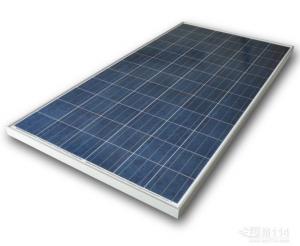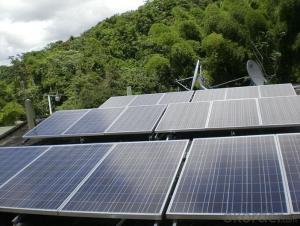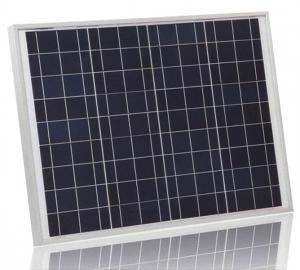Solar Panels for Sale in Los Angeles - Solar Panel Mono 260W, Solar Module
- Loading Port:
- Shanghai
- Payment Terms:
- TT OR LC
- Min Order Qty:
- 2600 watt
- Supply Capability:
- 26000 watt/month
OKorder Service Pledge
OKorder Financial Service
You Might Also Like
Specification
We now provide
• Monocrystalline Solar Panel
• Polycrystalline Solar Panel( multicrystalline silicon Solar Panel)
Features of our products:
• High conversion efficiency mono/poly-crystalline amorphous silicon solar cells
• Modules incorporate high performance bypass diodes to minimize the power drop caused by shading
• High transmittance, low-iron tempered glass
• High performance EVA encapsulant to prevent destroying and water.
• AI frame: without screw, corner connection. 8 holes on the frame can be installed easily
• Good performance of preventing from atrocious weather such as wind and hails
Limited Product Warranty
Under normal application, installation, use and service conditions, if MODULES fail to conform to this limited product warranty due to defects in material or workmanship, then for a period ending 12 years from date of sale as shown in the invoice or Contract issued by CNBM SOLAR. CNBM SOLAR will, at its option, either repair or replace or refund the purchase price as paid by the client for these defective MODULES. The repair or replacement or refund remedy shall be the sole and exclusive remedy provided under the “Limited Product Warranty” and shall not extend beyond the 12 years period set forth herein. It will be performed directly to the direct client only. This “Limited Product Warranty” does not warrant a specific power output, which shall be exclusively covered under “Limited Peak Power Warranty” as

Product Description:
This installation Manual contains essential information for the electrical and mechanical installation that your must know before installing CUSTOMER PV modules. This also contains safety information you need to be familiar with .All the information described in this manual are the intellectual property of CNBM and based on the technologies and experiences that have been acquired and accumulated in the long history of CUSTOMER. This document does not constitute a warranty, expressed or implied.
CUSTOMER does not assume responsibility and expressly disclaims liability for loss, damage, or expense arising out of in anyway connected with installation, operation, use or maintenance of the PV modules. No responsibility is assumed by CUSTOMER for any infringement of patents or other rights of third parties that may result from use of PV module.
CUSTOMER reserves the right to make changes to the product, specifications or installation manual without prior notice.
Solar panel working process
In addition to being the ultimate source of all life on earth, the sun is an infinitely renewable, completely pollution-free source of electricity. Instead of burning fossil fuels dug up from the ground in a big power plant – a very 19th century, industrial age approach, when you think about it – solar panels convert sunlight directly into electricity, with no harmful emissions.
The basic unit of a solar panel is a solar cell, which usually consists of one or two layers of silicon-based semiconductor wafers. When struck by the photons in sunlight, the solar cell generates an electrical charge due to the "photovoltaic effect" – which is a pretty good name, since it produces voltage from photons. The flow of these electrons moves in a steady electrical current from one side of the cell to the other.
Dozens of these PV cells are packaged together into solar modules, which in turn are packaged into solar panels that are mounted on a rooftop and arranged to maximize their hours of exposure to direct sunlight. Because the electricity generated by all those solar cells is direct current (DC), it is then sent to an inverter that transforms the power into the same alternating current (AC) used by the appliances in your home and the local utility electricity distribution grid. Increasingly, these inverters are getting "smart," providing data monitoring for solar installation performance and other grid integration services.
FAQ
We have organized several common questions for our clients,may help you sincerely:
③Can you provide the peripheral products of the solar panels, such as the battery, controller, and inverter? If so, can you tell me how do they match each other?
Yes, we can, we have two companies for solar region, one is CNBM International, the other is CNBM engineering Co.
We can provide you not only the solar module but also the off grid solar system, we can also provide you service with on grid plant.
④What is your warranty system?
Our product performance guarantees for 25 years
• 12 years guarantee for workmanship
• Timeliness of delivery
• Quality Products certified (TÜV, UL, CE, ISO)
⑤How do you pack your products?
We have rich experience on how to pack the panels to make sure the safety on shipment when it arrives at the destination.
- Q: Can solar panels be installed on windows?
- Yes, solar panels can be installed on windows. There are transparent solar panels available that can be installed on windows to generate electricity while still allowing light to pass through. These panels are designed specifically for windows and can be a great way to utilize the available space for solar energy generation.
- Q: Can solar panels be used to power a data center?
- Yes, solar panels can be used to power a data center. Solar panels convert sunlight into electricity, which can be used to power various devices and infrastructure, including data centers. By installing a sufficient number of solar panels and using energy storage systems, a data center can be powered entirely or partially by solar energy. This can help reduce reliance on traditional power sources, lower energy costs, and promote environmental sustainability. However, the feasibility and efficiency of using solar panels for powering a data center may depend on factors such as the location, size of the data center, and the availability of sunlight.
- Q: Can solar panels be used for powering water treatment plants?
- Yes, solar panels can be used for powering water treatment plants. Solar energy can be harnessed to generate electricity, which can then be used to power the various processes and equipment involved in water treatment plants. This environmentally-friendly approach helps reduce reliance on fossil fuels and contributes to sustainable water management practices.
- Q: Can solar panels be damaged by birds or rodents?
- Yes, solar panels can be damaged by birds and rodents. Birds may nest, perch, or peck at the panels, causing cracks or scratches on the surface. Rodents, on the other hand, can chew through the wiring or insulation, leading to electrical issues. Regular maintenance and bird deterrents can help minimize the risk of damage.
- Q: How much space do I need for solar panels?
- The amount of space required for solar panels depends on various factors such as the size and type of panels, the efficiency of the panels, and the energy needs of your household or facility. On average, a 1 kW solar panel system typically requires around 100 square feet of space. However, it is best to consult with a solar installer or expert who can assess your specific requirements and provide accurate information regarding the space needed for solar panels.
- Q: Can solar panels be installed on churches or religious institutions?
- Yes, solar panels can be installed on churches or religious institutions. In fact, many religious institutions are embracing renewable energy and installing solar panels on their roofs as a way to reduce their carbon footprint and contribute to a more sustainable future. Installing solar panels on churches not only helps them save money on energy bills but also sets an example for their congregations and communities by promoting clean and renewable energy sources.
- Q: Me and my wife just saw an ad on TV about going solar and saw the money we can save every month... any here have solar panels? How much do you save every month on energy bill? Is it true that your energy meter will spin backwards? lol
- You okorder The notion of spinning a meter backward has a lot of people plugging in their solar panel via an inverter- but this is a very bad idea and illegal as well- the power company requires a lockout device they control to kill power in their powlines for servicing and repairs- a plugged in solar panel and inverter can cause them injury or death. If you have about 30,000 dollars to invest (cost will vary), and you are going to be staying in your home for at least 0 years, contact your electric power utility as they will have the progams in place to do the installation on your site, and install the needed equipment for you to be legally grid tied. They will also have your paperwork prepared for your tax person come tax time. Most are actually seeking people out to do this, I won't go into details why, but by listening carefully to the power company in their presentation they will indirectly tell you why. Any installation that is intended to be grid tied MUST be approved by the power company and meet their specifications. Too many people are ignoring this last detail.
- Q: How do solar panels impact the local economy?
- Solar panels can have a positive impact on the local economy in several ways. Firstly, the installation and maintenance of solar panels create jobs, stimulating employment opportunities. Additionally, solar energy reduces the dependence on fossil fuels, thereby decreasing energy costs and increasing savings for businesses and households. This can lead to more disposable income, which can be spent locally, contributing to economic growth. Moreover, solar energy projects attract investments and promote the growth of renewable energy industries, further boosting the local economy.
- Q: How do solar panels affect the environment?
- Solar panels have a positive impact on the environment as they produce clean, renewable energy without emitting harmful greenhouse gases. They help reduce air pollution, combat climate change, and conserve natural resources by decreasing our reliance on fossil fuels. Additionally, solar panels have a minimal environmental footprint during their operation and can be recycled at the end of their lifespan, making them a sustainable energy choice.
- Q: I am in need of solar panels and the batteries that I can store the energy in. I need to be able to run a laptop, cell phone, and LED lights from it. When I research I see all sorts of options with regards to watts, VMPs, and AMPs. I also see that I may need a controller, an inverter, and various other components. Can anyone help me through these terms and what i need to know in order to efficiently generate and store the electricity. Thanks
- Okay well solar panels only work under sunlight and it saves alot of electricty as compared to your normal switches.And it also saves money=D.One thing though...it only works under sunlight...remember this fact. Power storage simply means a device which can store power. Well a generator stores power and a power station too!! Otherwise they can't flow through our electric current..... So for power usage simply is like on the fan/lights/mobile/computers/modems/e.t.c are considered as power usage as you are using the power=P Well hope this information helps you!
Send your message to us
Solar Panels for Sale in Los Angeles - Solar Panel Mono 260W, Solar Module
- Loading Port:
- Shanghai
- Payment Terms:
- TT OR LC
- Min Order Qty:
- 2600 watt
- Supply Capability:
- 26000 watt/month
OKorder Service Pledge
OKorder Financial Service
Similar products
Hot products
Hot Searches
Related keywords

























